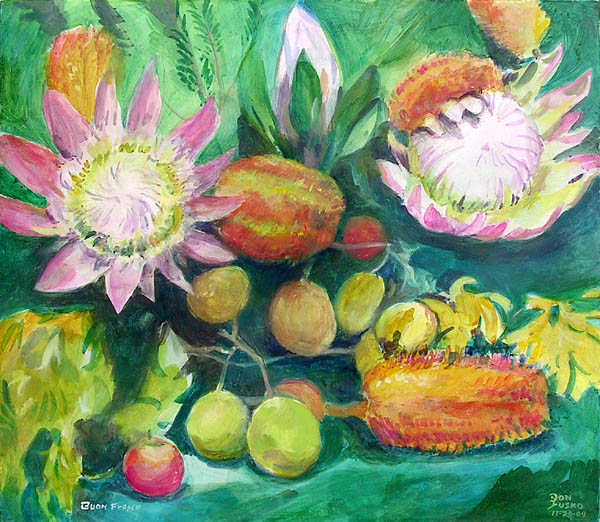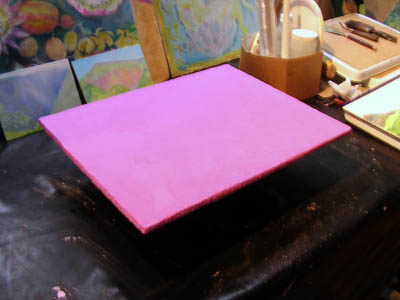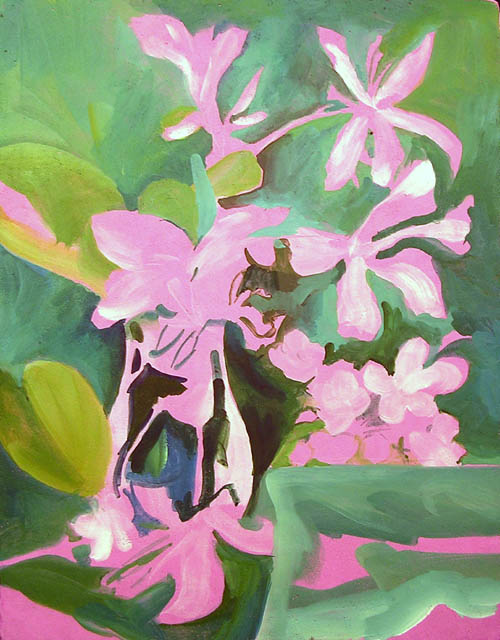|
This should be the last fresco test I have to do, 01-19-05.
"What is the compared open time between white cement and lime mortar?"
I made two 8.5 inch tiles. One with a white cement rough and one with a lime rough, both with 1:2 small sand. Two weeks later I put on the intonaco, 1:1.
3:22, both roughs were covered with smooth intonaco, 15 minutes later I gave them a final troweling and removed any cream from the top.
3:45, I painted on the division lines on both tiles with a #1 rigger, a very long haired round ferrule with a flat end. Notice the top line of the lime tile, it is lighter because lime mixed with the pigment even though I used a very soft wash brush. It's still worth while though because it gets the location points in early.
Every hour I painted in a section, cadmium red, red oxide, gold ocher, burnt sienna and red oxide again.
6:00, the lime is still soft and the white cement is much harder.
8:00, a little carbonate crust was forming on the lime so from here out I will be wetting the mortar with lime water.
8:30, another wash of lime water and a pressure troweling of all the remaining sections. The white cement mortar is hard, will it still be absorbing pigment? It paints nicely.
9:00, both are absorbing more slowly. I give them another lime water wash.
10:22, I was a little late, because I was watching the Australian tennis tournament. The white cement was singing.
11:00, the last section to be painted. I repressed the sections with the trowel. The white cement was hard. I don't give the white cement mortar much of a chance to hold the pigment, but I won't know for sure for two days, when I wash down the frescos and remove any loose pigment that didn't absorb.
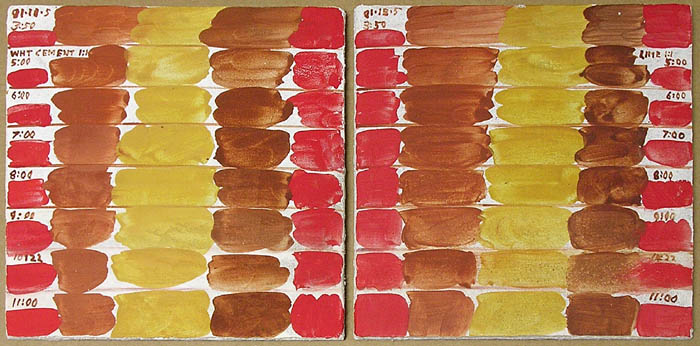
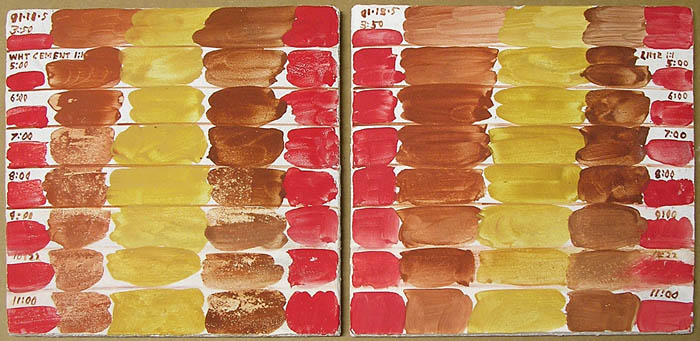
I'll point out the changes after the tiles were washed. On the first line, the white cement stayed the same. On the lime tile, because it was painted while the lime was very wet, the lime moved and mixed with the pigment. The final effect was it dried lighter.
One hour later, 5:00, the cement and lime both worked very well.
Two hours later, the cement didn't hold the pigment where it was the densest. It flaked off the red oxide which is an excellent fresco color.
Three hours later, the white cement failed. The lime was just getting started.
Four hours later, both the red oxide and burnt sienna failed in the cement. The yellow ocher held it's ground on both tiles.
Five hours later, 9:00, the cadmium red and yellow ocher were lighter on the cement. The lime still had no changes.
Six hours later, some red oxide flaked off the cement, the lime is still going strong with no changes.
Seven hours later, 11:00. The white cement continued to deteriorate, all colors were failing. The last color down was cadmium red, which I laid on three times letting the shine disappear before adding the next layer. It worked, but... Be cautious about adding any white cement to the lime intonaco. Use no more than 20 percent if you want to be safe.
The answer to the question is.. One hour for white cement verses seven hours for lime. If the lime is well taken care of, i.e. keeping it moist with lime washes and pressure troweling the unpainted areas as time goes on. With correct moisture and re-pressing the lime I have gone 10 hours.
These links are to other 3 primary color paintings, the pigments are:
Dry Pigments;
Indian yellow PY153 from Zecchi,
Magenta PR122 from Sennelier,
Cyan PB15.3 from Senopia.
Food Coloring
The Easter Egg Coloring 6-pack w/ transparent cyan & magenta.
Oil Paints,
Old Holland Indian Yellow Orange-side,
Daniel Smith Quinacridone Magenta PR122,
Grumbacher Thalo Blue, cyan PB15.3
Water Colors,
Daniel Smith New Gamboge PY153 Nickel Dioxine is the best Indian Yellow O/s pigment.
Daniel Smith Quinacridone Magenta PV202 is more to the cyan side.
Grumbacher Thalo Crimson PV19 is more to the warm side.
I don't know why they won't use the most stable and magenta matching pigment PR122.
Grumbacher Thalo Blue PB15.3
Children painting with Food Coloring Colors First Grade learning the primary colors.
3 color examples Mixing the three transparent primary colors.
Lime Water Medium 75 sq. foot Buon Fresco in 3 colors.
Lime Water Medium Buon Fresco #1 in 3 colors. frescopaintings11.htm
Lime Water Medium Buon Fresco #2 in 3 colors. frescopaintings12.htm
Maroger Medium Hana Paintings with Maroger's Medium in 3 primary colors.
Maroger Medium The Kaupo Hearts, Black Oil painting in 3 primary colors.
Egg Tempera Medium Still Life in 3 primary colors.
Water Color Painting with 3 primary colors.
Copal Medium with the RCW 3 Color Wheel
|
